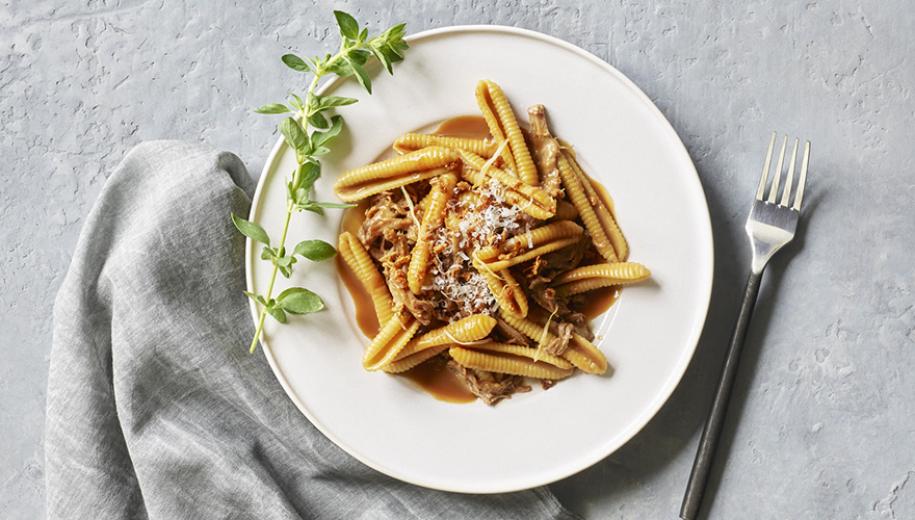1 10
1 10
Global food fusions are nothing new, but look for some especially exciting flavor combinations in 2022. One that’s on the rise is Itameshi, which brings together Japanese and Italian cuisines for something truly unique. An example is tarako spaghetti, which combines pollock roe with spaghetti along with butter, soy sauce, and dried seaweed, creating a delicious umami explosion. Another is wafu Italian soy ginger pork ragu with sesame ricotta cavatelli (shown above) from Chef Robbie Felic of pasta RAMEN in New Jersey. Photo courtesy Kikkoman
Another cuisine mashup to look for in 2022: Korean and Spanish. Pictured here is Korean paella from Chef Peter Lee, co-owner & chef at Secret Bao in Santa Barbara, Calif. Photo courtesy Kikkoman
Street food is increasingly finding its way onto restaurant and catering menus. Tacos, elotes (Mexican grilled corn with cheese), Chinese bao buns (shown), and more are popping up as butler-passed bites, and on plated meals and action stations. “For a caterer, street food just makes so much sense,” said Michael Stavros, with M Culinary Concepts, during his food trends session at Catersource + The Special Event 2021. “But now street food needs to be elevated a little bit. We can dress it up; we can make it fun, and we can make it elegant.” (Check out the speaker lineup for Catersource + The Special Event 2022, which convenes May 2-5 in Anaheim, Calif.)
Plant-based “meat” has moved from unorthodox to mainstream. What started off as a few menu offerings has grown into a full-blown dining alternative, with everything from carrot hot dogs to mushroom “crab cakes.” “It’s not just for the vegan audience anymore,” said Mark DiDomanico with Datassential during a recent webinar hosted by Nation’s Restaurant News. Chef Bob Bankert, University of Massachusetts, agreed: “We really can’t get plant-based options on the menu fast enough right now.”
While not everyone is ready to embrace a fully plant-based menu, veggies are making a move from a side dish to the main course. This is embraced by both “flexitarians” who primarily eat plants with the occasional inclusion of meat, eggs, and dairy, and “reducetarians,” who are committed to mindfully and gradually reducing their consumption of animal products. When animal products are on the menu, reducetarians make them count, opting for premium grass-fed meat and eggs from pasture-raised chickens.
As chefs look for creative ways to elevate their dishes, 2022 will see the rise of several ingredients and flavors. One standout is Yuzu. Tart and sour, this lesser-known citrus fruit is popping up in vinaigrettes, hard seltzers, mayos, and more. Its lime-lemon-grapefruit flavor is also great for accenting soups, veggies, noodles, and fish.
Hibiscus is another ingredient that will reign in 2022. While it has long been a delicious addition to beverages and cocktails, chefs will soon be harnessing its sweet-and-tart flavor for use in spreads and yogurts. Don’t underestimate the appeal of hibiscus’ signature pink hue.
Moringa, long used as an herbal remedy in India and Africa, is often described as having a grassy profile, like that of wheatgrass, spinach, or kelp. Moringa leaves, powders, and oils are growing in popularity due to their health properties, and will be making their way into cocktails, sauces, and desserts. “[Moringa] is a literal super food, and we can sneak this into our diets really seamlessly,” said Zoe Adjonyoh, owner of Zoe’s Ghana Kitchen, during the cocktail-focused conference, Tales of the Cocktail 2021.
While 2021 was all about high-octane cocktails as people indulged on the heels of the pandemic, 2022 will once again see temperance cocktails hit bar menus around the country. “It’s not just people who don’t drink at all, but there are some people who just don’t drink as much,” said Derek Brown with Spiritless during the Tales of the Cocktail 2021 event. With so many non-alcoholic spirits now available (Seedlip, Spiritless, and Damrak, for example), temperance cocktails can provide the taste and sophistication of traditional cocktails.
Nostalgia is the name of the game for desserts in 2022. Treats from the 1980s and 1990s, like cherry bakewell, lemon drizzle, and sticky toffee pudding, will be sought for their ties to childhood memories and simpler times. Pictured above is the nostalgic peanut-butter mousse served during last fall’s International Foodservice Editorial Council conference. Fantasy-inspired desserts (think unicorns, mermaids, bubblegum, and rainbows) should also be on the radar for their sense of escapism, as well as their appealing visuals. Photo courtesy Buzz Orr multimedia

